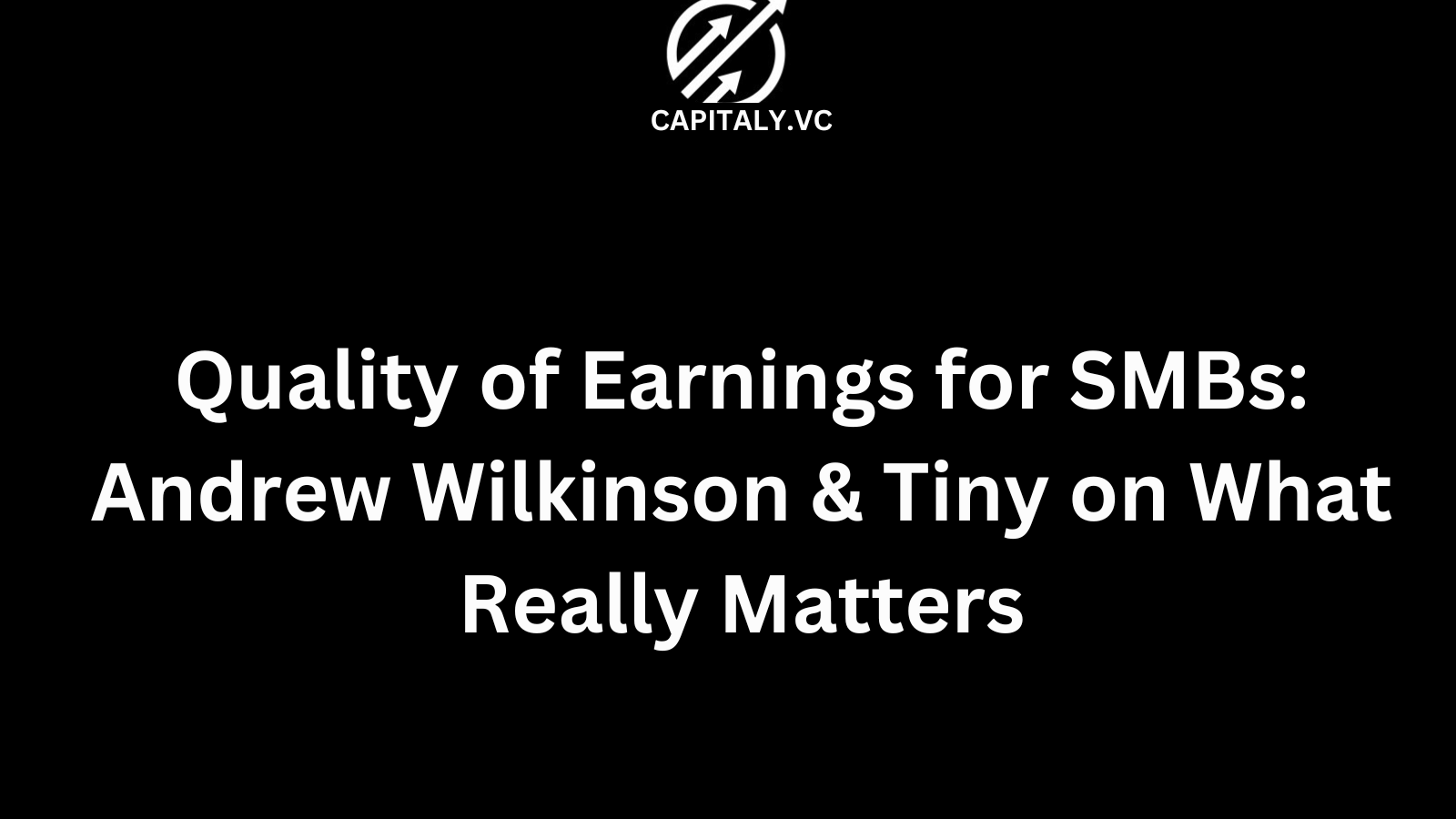Quality of Earnings for SMBs: Andrew Wilkinson & Tiny on What Really Matters
Quality of Earnings for SMBs: Andrew Wilkinson & Tiny on What Really Matters

Quality of Earnings for SMBs: Andrew Wilkinson & Tiny on What Really Matters is the straight, plain-English checklist I use to separate real cash from accounting noise.
I’ll show you the exact signals I look for.
I’ll keep it simple, founder-friendly, and focused on net proceeds, not paper profit.
If you want to write tighter during a QoE sprint, see our post: I Don’t Respond to Long Emails.

What “Quality of Earnings” really means for an SMB
I define QoE as proof that your earnings are repeatable, cash-backed, and defensible.
Not just “higher.”
Repeatable means next month looks like last month, minus known seasonality.
Cash-backed means the P&L ties to bank statements.
Defensible means a smart buyer can underwrite it without squinting.
For staying focused while you prepare, read: Delete 95% of Your Email.
Cash vs accrual: the tie-out buyers check first
I reconcile revenue to bank deposits.
I show a simple cash→accrual bridge.
I label each add-back in one sentence.
If revenue doesn’t tie to cash, the multiple shrinks.
Revenue recognition in plain English
I write the policy in 5 lines.
I show one invoice per revenue type all the way to the bank.
I note any change in terms and the effect on churn.
Clarity beats cleverness.
Add-backs: the good, the bad, and the fiction
Good: one-time legal fees, founder relocation, shut-down products.
Bad: ongoing “temporary” contractors, permanent discounts labeled “promos.”
Fiction: “owner salary” add-back when a replacement costs the same.
If I can’t defend it to a CFO in two sentences, I cut it.
Seasonality and normalization without drama
I show 12–36 months of monthly P&Ls.
I mark normal peaks and troughs.
I normalize for one-offs but never for real seasonality.
Buyers price reliability, not miracles.
Customer concentration and durability
If your top customer is >25% of revenue, I show contracts and renewal history.
I map the plan to reduce reliance in the next 12 months.
Durability = diversified customers + sticky contracts.
Gross margin truth and mix shift
I break margin by SKU, channel, or cohort.
I explain any shift in discounting or shipping policy.
I prove that the last price increase stuck.
Margin trend > margin snapshot.
Operating expenses: what quality looks like
I split run-rate opex vs project-based spend.
I tag experiments, pilots, and wind-downs.
I show the steady state needed to keep the machine printing cash.
Working capital behavior and the peg
I show AR, AP, inventory, deferred revenue as a rolling 12-month picture.
I compute a fair peg using the monthly average and seasonal logic.
The peg paragraph moves six figures.
For a quick primer, see: Working Capital Peg Explained (read for the cadence; keep your peg note equally short and clear).
Deferred revenue: the SaaS and services gotcha
I treat deferred as a real liability.
I match it to delivery cost and capacity.
If prebilling spiked pre-LOI, I explain why and normalize it.
Cohorts and retention that a buyer trusts
I show GRR and NRR by month.
I annotate why cohorts bend and how we fixed it.
I’d rather show a dip with a fix than hide it.
Unit economics and contribution margin
I prove CM per order/customer after variable costs.
I show CAC, payback, and LTV with the exact data sources.
If ads paused tomorrow, I show the cash the base would still throw off.
AR/AP aging and bad-debt reality
I reserve for old AR.
I explain any DSO stretch in the last 60 days.
I cap AP “stretching” by comparing to the 12-month average.
No end-of-deal games.
Inventory valuation and obsolescence policy
I value at lower of cost or NRV.
I identify dead stock and write-downs.
I show turns improving through SKU cleanup.
Tax posture and sales-tax nexus for SMBs
I list jurisdictions, filings, and any clean-up plan.
I confirm payroll, sales tax, and GST/VAT status.
No skeletons.
Keep the language tight and human like this: Never Tell, Always Storytell.
EBITDA to free cash flow: the bridge that matters
I start with EBITDA.
I subtract maintenance capex.
I adjust for working capital.
I land on unlevered FCF.
That’s what buyers underwrite.
Forecasts buyers actually believe
I bridge TTM → next 12 months using three levers: price, mix, efficiency.
I run a downside case with your real constraints.
I never show a hockey stick without resourcing to match.
Common QoE red flags and how I fix them
Red flags: revenue tied to one platform, murky add-backs, negative cohort trends.
Fixes: diversify channels, cut fiction, show cohort repair with dates and owners.
I don’t hide the bruise.
I show the bandage.
Data room and evidence pack
I upload the vital 20% first: TTM P&L tied to bank, top-20 customers by month, AR/AP aging, contracts, org chart.
I answer questions in one thread.
I move fast and keep receipts.
For rhythm, subscribe to the Newsletter and skim the Podcast.
Run a DIY “QoE-lite” in 10 days
Days 1–2: build cash→accrual bridge and label add-backs.
Days 3–4: margin by SKU/channel + unit economics.
Days 5–6: cohorts, GRR/NRR, and pricing events.
Days 7–8: working capital and peg memo.
Days 9–10: EBITDA→FCF bridge, checklist, and one-pager.
If you need a mindset reset, read: A $3,600 Keyboard and a $66 Million Dollar Investment.
Examples you can steal
Example A — Add-back sanity.
You spent $120k one-time migrating CRMs.
You cut it once.
You do not also add back the new CRM’s ongoing $2k/month.
That’s run-rate.
Example B — Deferred revenue truth.
You pre-billed $500k for annual plans.
You recognize $41.7k/month and carry the liability.
You show capacity to fulfill without new hires.
The multiple holds.
Example C — EBITDA→FCF bridge.
EBITDA $3.0M.
Maintenance capex $300k.
Working capital increase $200k.
Unlevered FCF $2.5M.
That’s the number I pay for.
Copy-paste QoE checklist (short-form)
- Tie-outs: P&L → bank; cash→accrual bridge.
- Add-backs: labeled, evidenced, truly non-recurring.
- Margins: by SKU/channel; discount policy noted.
- Cohorts: GRR/NRR, causes, fixes.
- Unit economics: CM, CAC, payback, LTV.
- Working capital: AR/AP aging, inventory, deferred; peg memo.
- Tax: jurisdictions, filings, exposure.
- EBITDA→FCF: maintenance capex + WC delta.
- Contracts: top customers, renewals, change-of-control.
- Data room: vital 20% first; one thread for Q&A.
FAQs
What’s the difference between audited financials and a QoE.
Audits check compliance.
QoE tests earnings quality and durability for a buyer.
Do I need a Big-4 QoE to sell.
No.
For SMBs, a crisp QoE-lite with clean tie-outs often closes the gap.
What’s the fastest way to improve QoE.
Fix add-backs, working capital hygiene, and cohort clarity.
Those three move the needle first.
How far back should I show data.
Minimum 24–36 months monthly.
More if you have it.
Monthly beats annual.
Can I normalize owner salary.
Yes, to a market replacement cost.
Not to zero.
How do I handle a recent price increase.
Show churn before/after and the net revenue effect.
Buyers price proof, not promises.
What if my top customer is 30% of revenue.
Show contract terms, renewal history, and a dilution plan.
Price can still be strong with evidence.
Should I include pipeline in QoE.
As color, not as earnings.
Keep QoE about what happened, not hopes.
How big are typical peg swings at close.
Six figures is common.
Seven figures in inventory-heavy models.
What’s the single most important QoE page.
The EBITDA→FCF bridge with sources.
Cash wins.
Conclusion
Quality of Earnings for SMBs: Andrew Wilkinson & Tiny on What Really Matters is about proving that your profit is repeatable, cash-backed, and defensible.
Tie the P&L to the bank.
Clean the add-backs.
Show cohorts, margins, and a fair peg.
Bridge EBITDA to free cash flow and move fast with receipts.
Get Your Copy of Never Enough at https://www.neverenough.com/



.png)